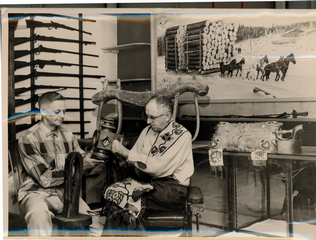During the fall of 1938, at a meeting of the Thief River Falls chapter of the Society for the American Sons and Daughters of Sweden, it was voted to begin the process of building a Pennington County Historical Society. The earliest County Historical Museum was a room in the basement of the Thief River Falls City Auditorium. Officers were elected, by-laws and incorporation papers were prepared and filed, local families were contacted and asked for donations of artifacts to display in the new Museum. Many of these items had been part of a local home or business from the 1880’s through the 1930’s and most of those things are still on display at the current Peder Engelstad Pioneer Village Museum.
The biggest change over the past 75 years came in the mid-1970’s, after about ten years of discussion that acknowledged the need for a larger space for displaying the rich heritage of the community, when the leadership of the Society was given the land surrounding the old sewage treatment plant between Highway 32 and Oakland Park Road and began to move buildings from other parts of the county and a few surrounding counties, to make up a Village, complete with church, school, railroad depots, homes, stores and offices.

With this larger space and the addition of those authentic and charming structures that many people both from the area and from far away love to visit, however, comes an increased need for donations to help to keep the buildings in good condition and to restore display pieces so that they represent the history in a positive way.
Now that the original generation of the pioneers of Pennington County is no longer with us, to tell us their stories first-hand, it is even more crucial that we protect and preserve the items left by them to show how they lived their lives and interpret the use of these items accurately.
Many people probably believe that because the Society is called the “Pennington County Historical Society”, it is under the care and authority of Pennington County. This is not the case. The Society is an independent non-profit organization, which, in fact, does receive a stipend from the County and also grounds maintenance service from the City’s Park and Recreation Department. However these funds do not fully cover the costs of maintaining the buildings or for staffing the Museum.
There are several ways of supporting these ongoing activities to preserve community history. The purchase of a membership can be the basis of annual fundraising and gives the member a number of benefits. Please check out the Membership page on this site for more information on what you can get in exchange for supporting the Society.
Many donations of artifacts and photographs each year are presented (or loaned) to the Museum so that others can enjoy them, too. You do not have to be a member of the Society to donate items, but, of course, we hope that you will join. This can expedite the process of bringing an item in to donate. It is, of course, a good idea to phone or visit the Museum and speak with the staff about how (and whether) the Museum can use the donation you have in mind.
When an artifact is donated to the Museum, information about it is recorded, including who donated it, what it is and how it was used, and other pertinent facts about the item. A picture or scan of the item is made and then entered into the Museum’s system and becomes searchable for others to see not only at the Village but online as well. With the display of the image is also the name of the person(s), or family that donated the item and the information about it. We believe in honoring those that contribute to the preservation of our community history.
Some members of the Society have gone above and beyond the basics with donations of money, time and energy, in sponsoring special events, serving on the board of directors, or contributing to the endowment fund, which provides a lasting investment for the Society to use to preserve and maintain the displays for the benefit of visitors and those who love history.